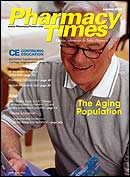Publication
Article
Pharmacy Times
coagulation counseling
Author(s):
Dr. Garrett is a clinical pharmacist practitioner at Cornerstone Health Care in High Point, NC.
USE OF HEPARIN REDUCES RATE OF CATHETER-RELATED INFECTIONS
Catheter-related infection (CRI) isthe most common life-threateningcomplication of central venouscatheter placement. More than200,000 cases are reported annuallyin the United States. Catheters are themost common cause of bloodstreaminfection and are associated with substantialexcess in mortality, length ofhospital stay, and cost.
Experimental studies suggest a closerelationship between catheter thrombosisand infection. Several proteinsfound in clots are able to increaseadherence of staphylococci andCandida species to catheters. Previousstudies have demonstrated that a fibrinsheath surrounding the catheter greatlyenhances catheter colonization.Animal studies have shown that subcutaneousenoxaparin, a low-molecular-weightheparin, is able to decrease thefibrin-sheath formation and the incidenceof catheter colonization byStaphylococcus epidermidis.
Recent clinical trials suggest thatheparin could reduce catheter-relatedbloodstream infections. A randomizeddouble-blind study in critically ill childrenhas shown that heparin-bondedcatheters reduce thrombosis and positiveblood cultures (drawn throughthe catheter). A significant decrease inCRI has also been demonstrated inbone marrow transplant patients whowere given low daily doses of heparin.No adverse effects of heparin werenoted in either study. These results,which need to be confirmed in largerstudies, suggest that heparin may providea low-cost method of reducingthe incidence of a very expensivecomplication of catheter use.
EPTIFIBATIDE MAY HELP SICKLE-CELL PATIENTS
Researchers at the University of North Carolina have published results of a small studyusing eptifibatide (Integrilin; Schering-Plough) to treat sickle cell disease. Sickle cell disease,an inherited disorder, causes malformations in red blood cells that cause painfulepisodes (crises) when they block blood vessels. Hydroxyurea is the only medication currentlyapproved to treat sickle cell disease.
A small phase 1 study done at the University of North Carolina evaluated the effect ofeptifibatide on platelet aggregation and CD40 ligand (CD40L), both of which are thought toplay a role in sickle cell crisis. The study included 4 patients who were not in an acute paincrisis. They were given intravenous infusions of eptifibatide, which is most commonly usedin acute coronary syndrome (ACS) and during coronary stent placement. No patients experienceda pain crisis during the study. Decreases in platelet aggregation and CD40L weresimilar to those observed in ACS. Further study will be required in larger numbers ofpatients before eptifibatide can be recommended as a treatment for sickle cell disease.
HIGHER DOSE OF CLOPIDOGREL CUTS RISK OF CORONARY EVENTS
Pretreatment with a double dose of clopidogrel just before percutaneous coronaryintervention (PCI) cuts the combined risk of heart attack and cardiac death by half,according to a new study. Researchers found that giving patients at least 600 mg ofclopidogrel before stenting, rather than the standard 300-mg dose, halved the risk ofmajor complications associated with thrombosis. The higher dose did not increase therisk of serious bleeding.
The research, which was a meta-analysis of data from 10 studies, included morethan 1500 patients. Overall, pretreatment with high-dose clopidogrel (600 mg or more)was associated with a 50% reduction in the risk of cardiac death or nonfatal heartattack, both during the initial hospitalization and within 30 days of the PCI procedure,a finding that was very statistically significant. There was no statistically significantincrease in major or minor bleeding. Findings remained the same when the analysiswas restricted to randomized controlled trials only. Subanalysis showed that the higherthe underlying risk of complications related to blood clotting, the greater the benefitfrom high-dose clopidogrel.
VITAMIN E LOWERS THROMBOSIS RISK
A recently published study found a decrease in the risk of venousthromboembolism (VTE) in women who received vitamin E supplementation.In this randomized, placebo-controlled study, 39,876women aged 45 or older received a supplement of 600 IU of naturalsource vitamin E on alternate days.
During the 10-year study, VTE occurred in 482 women (213 in thevitamin E group, 269 in the placebo group). This represented a 21%hazard reduction. For unprovoked VTE, the reduction was 27%. In subgroup analyses, the3% of participants who reported VTE before randomization had a 44% hazard reduction,whereas women without prior VTE had an 18% reduction. Women with either factor VLeiden or the prothrombin mutation had a 49% hazard reduction with vitamin E treatment.The researchers concluded that supplementation with vitamin E may reduce the risk ofVTE in women, particularly those with a prior history of VTE or a genetic predisposition.







